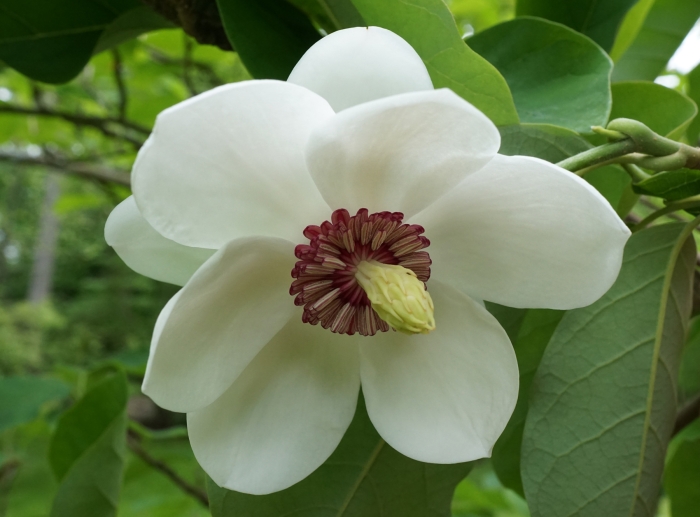Korean Mountain Magnolia
(Magnolia sieboldii)
Korean Mountain Magnolia (Magnolia sieboldii)
/
/

Plant Image Library from Boston, USA
CC BY-SA 2.0
Image By:
Plant Image Library from Boston, USA
Recorded By:
Copyright:
CC BY-SA 2.0
Copyright Notice:
Photo by: Plant Image Library from Boston, USA | License Type: CC BY-SA 2.0 | License URL: https://creativecommons.org/licenses/by-sa/2.0 | Uploader: Ser Amantio di Nicolao | Publisher: Wikimedia Commons | Title: Magnolia_sieboldii_(Oyama_Magnolia)_(34189107584).jpg | Notes: {{Information |Description ={{en|1=Location taken: Else Kientzler Botanical Garden, Sarchi Norte, Costa Rica. Names: Musa basjoo Siebold, Ba Jiao, Ba Jiao You, Bananier Basjoo, Bananier Du Japon, Bash











































Estimated Native Range
Summary
Magnolia sieboldii, commonly known as Korean Mountain Magnolia, is a deciduous shrub or small tree native to forest margins, valleys, and along streams in East Asia, including Korea, Japan, and parts of China. It typically grows 5–10 m (16–33 ft) tall and is noted for its downy stalks, young leaves, twigs, and buds. The flowers are particularly striking, with pendulous, cup-shaped blooms measuring 7–10 cm in diameter. They feature 6-12 tepals, with the outer three being smaller and the rest larger, all pure white, while the carpels are greenish and the stamens are reddish-purple or greenish-white. The flowering season extends from early to late summer, with blooms that are moderately showy and emit a subtle fragrance.
Korean Mountain Magnolia is valued for its ornamental beauty and is one of the hardiest magnolias, capable of thriving in cooler climates as demonstrated by its success at Arboretum Mustila in Finland. Its resilience and elegant flowers make it a popular choice for gardens and parks. It can be used as a specimen plant or in mixed borders. The cultivar ’Colossus’ has received the Royal Horticultural Society’s Award of Garden Merit, indicating its exceptional qualities. For optimal growth, it prefers full sun to part shade, medium water, and well-drained soils. While generally low-maintenance, it can be susceptible to leaf spot and canker diseases, and it may require protection from strong winds due to its pendulous flowers.CC BY-SA 4.0
Korean Mountain Magnolia is valued for its ornamental beauty and is one of the hardiest magnolias, capable of thriving in cooler climates as demonstrated by its success at Arboretum Mustila in Finland. Its resilience and elegant flowers make it a popular choice for gardens and parks. It can be used as a specimen plant or in mixed borders. The cultivar ’Colossus’ has received the Royal Horticultural Society’s Award of Garden Merit, indicating its exceptional qualities. For optimal growth, it prefers full sun to part shade, medium water, and well-drained soils. While generally low-maintenance, it can be susceptible to leaf spot and canker diseases, and it may require protection from strong winds due to its pendulous flowers.CC BY-SA 4.0
Plant Description
- Plant Type: Tree, Shrub
- Height: 10-15 feet
- Width: 10-15 feet
- Growth Rate: Slow
- Flower Color: White
- Flowering Season: Spring, Summer
- Leaf Retention: Deciduous
Growth Requirements
- Sun: Full Sun, Part Shade
- Water: Medium
- Drainage: Medium
Common Uses
Bee Garden, Bird Garden, Butterfly Garden, Deer Resistant, Fragrant, Hummingbird Garden, Showy Flowers, Street Planting
Natural Habitat
Forest margins, valleys, and along streams in East Asia
Other Names
Common Names: Korean Mountain Magnoliaoyama Magnolia, Siebold’s Magnolia, Buskmagnolia, 함박꽃나무
Scientific Names: , Magnolia sieboldii, Magnolia seiboldii, Magnolia oyama, Magnolia parviflora f. variegata, Oyama sieboldii,
GBIF Accepted Name: Magnolia sieboldii K.Koch